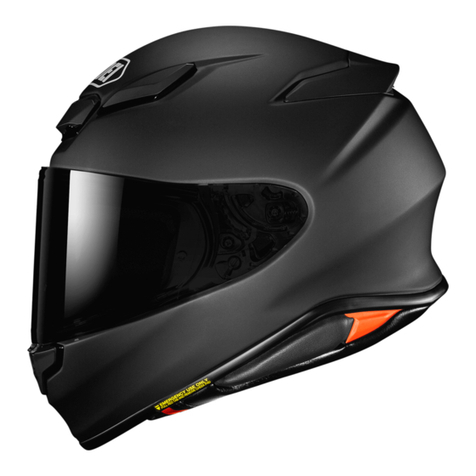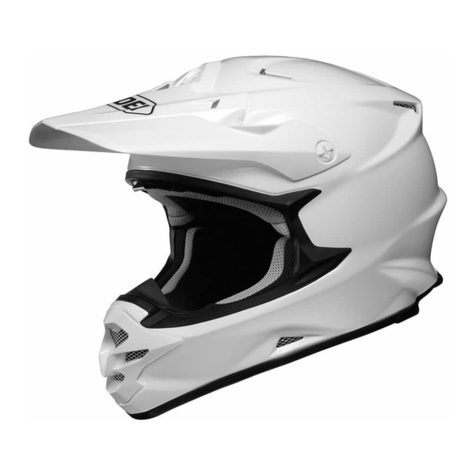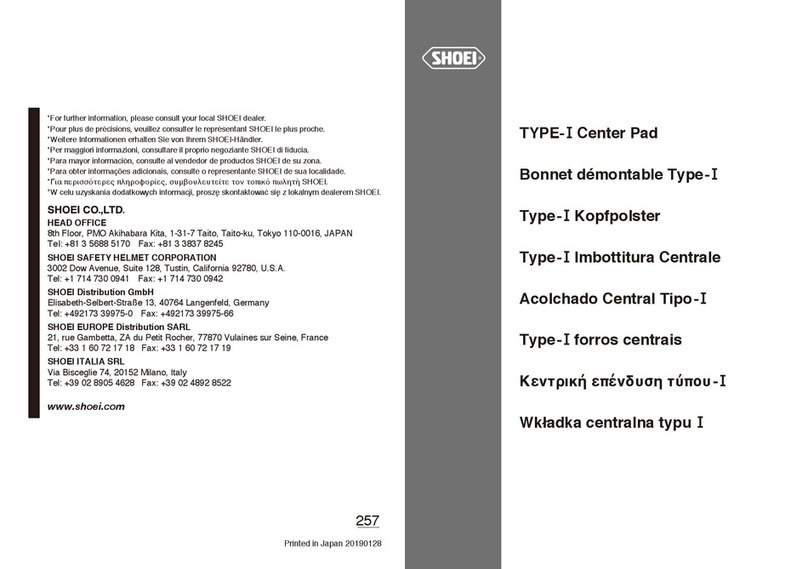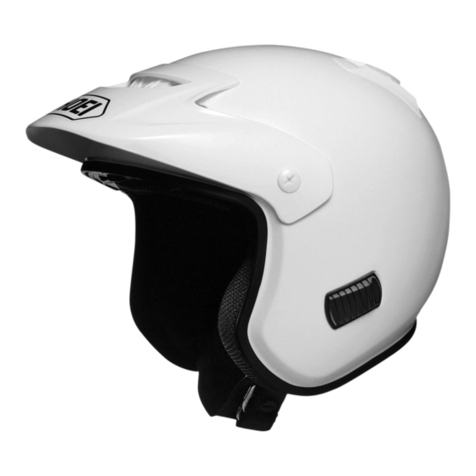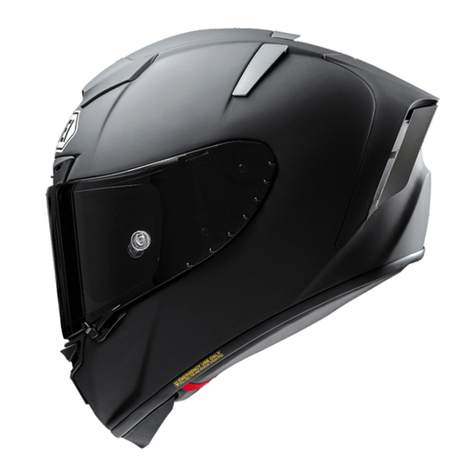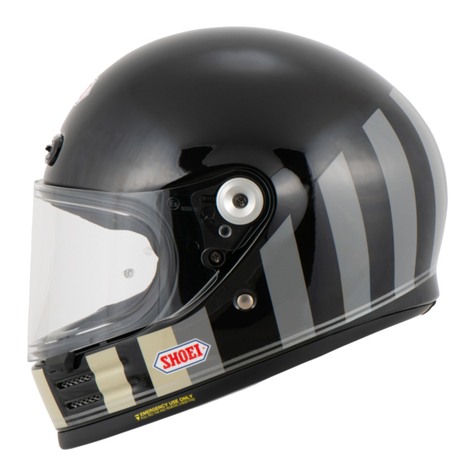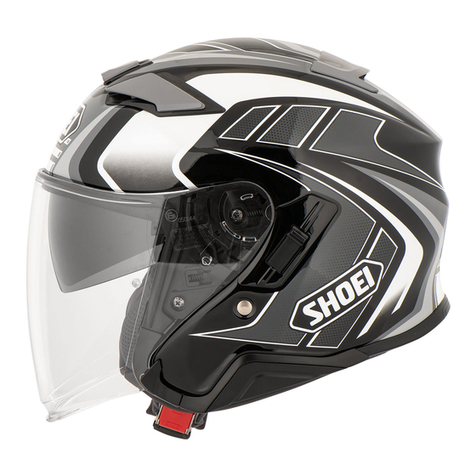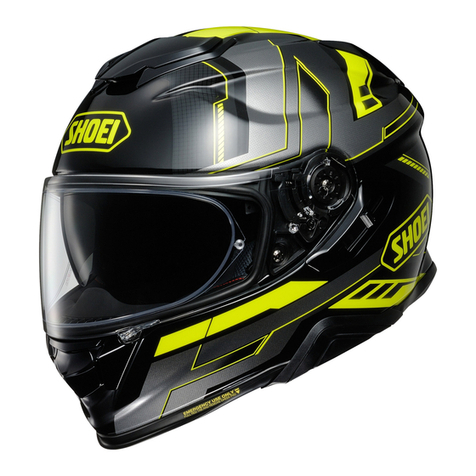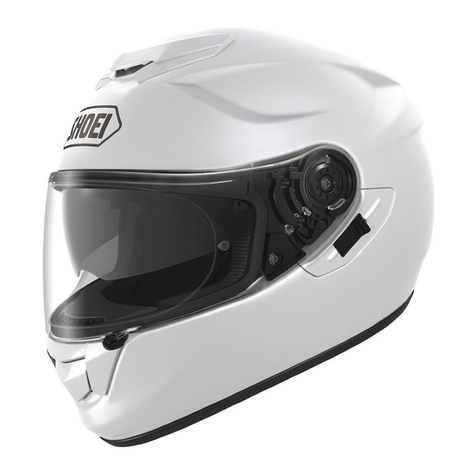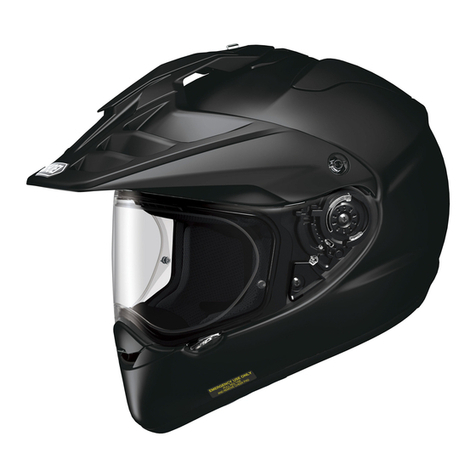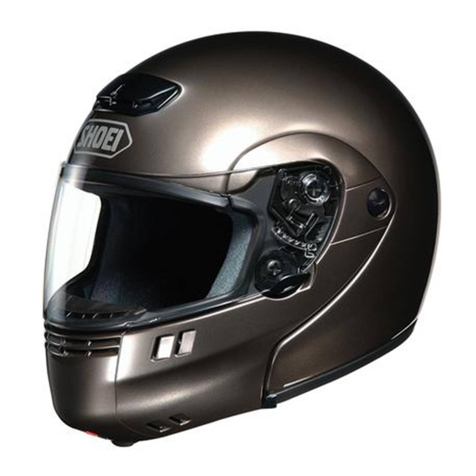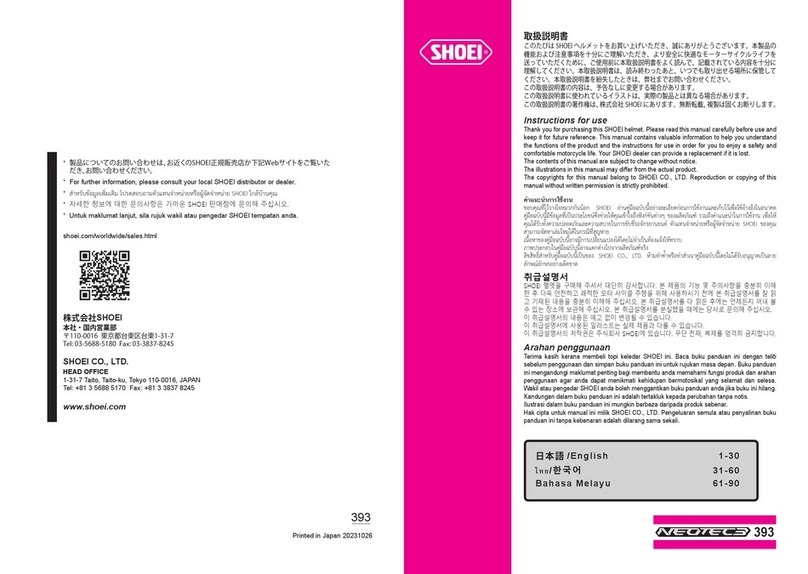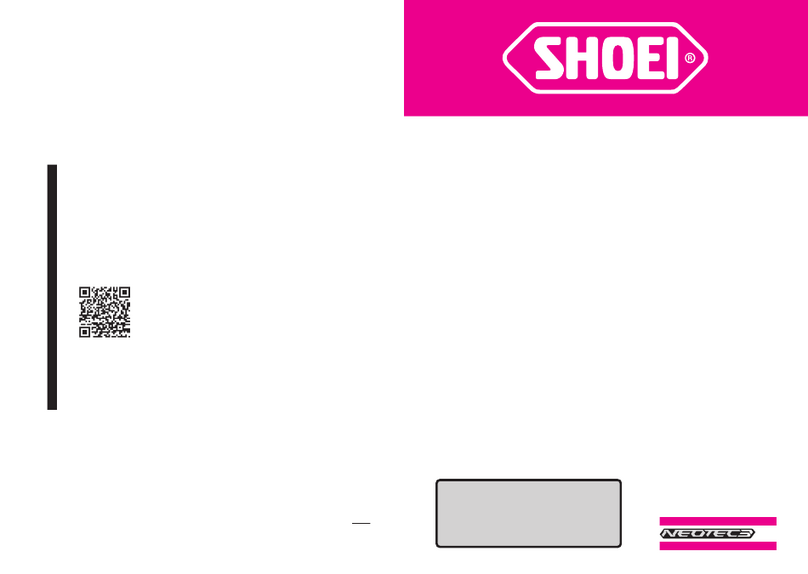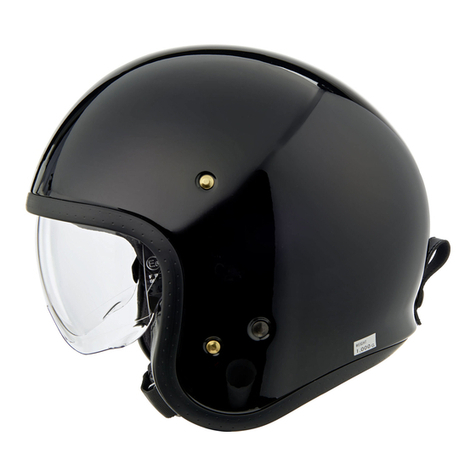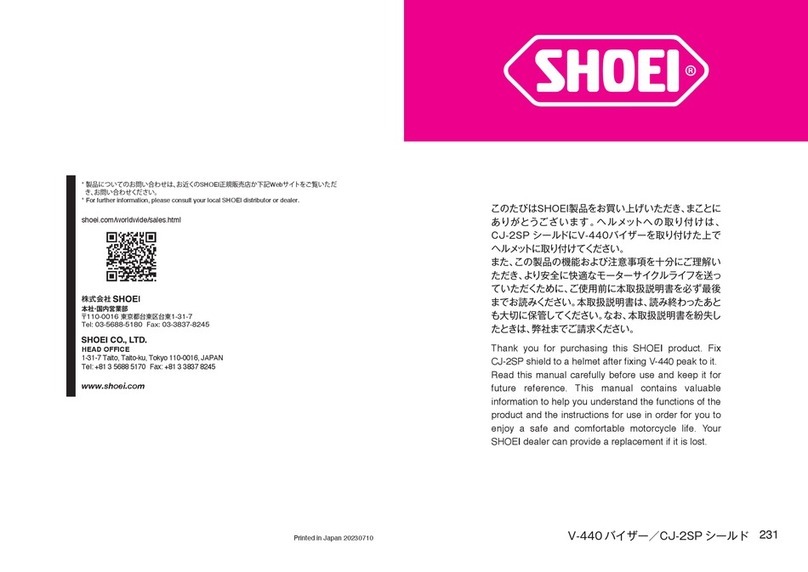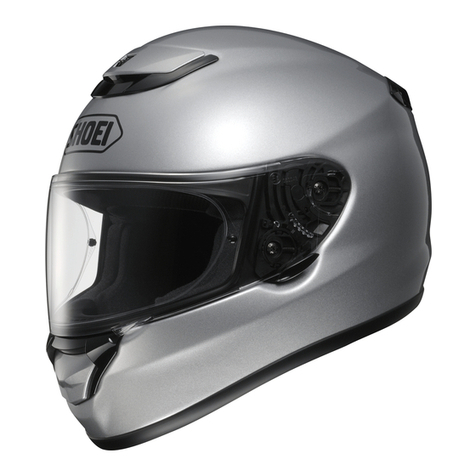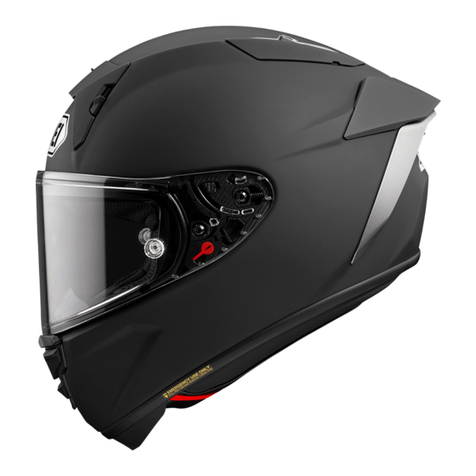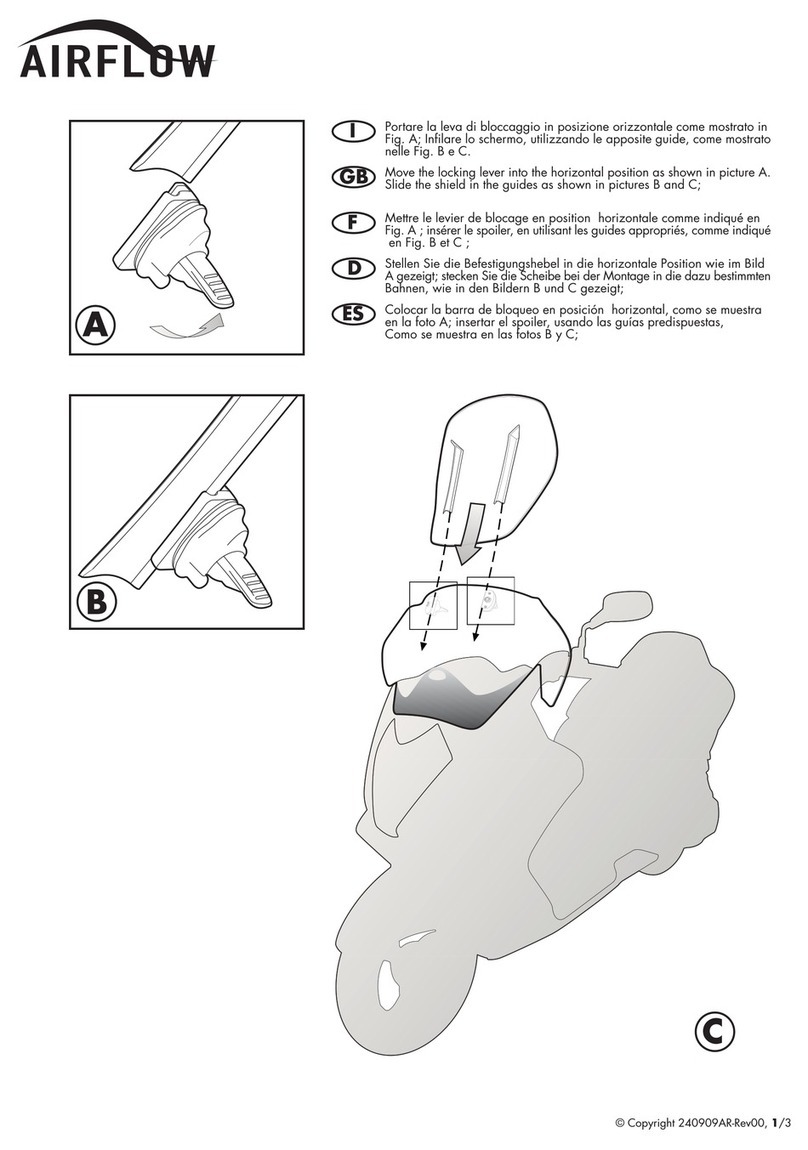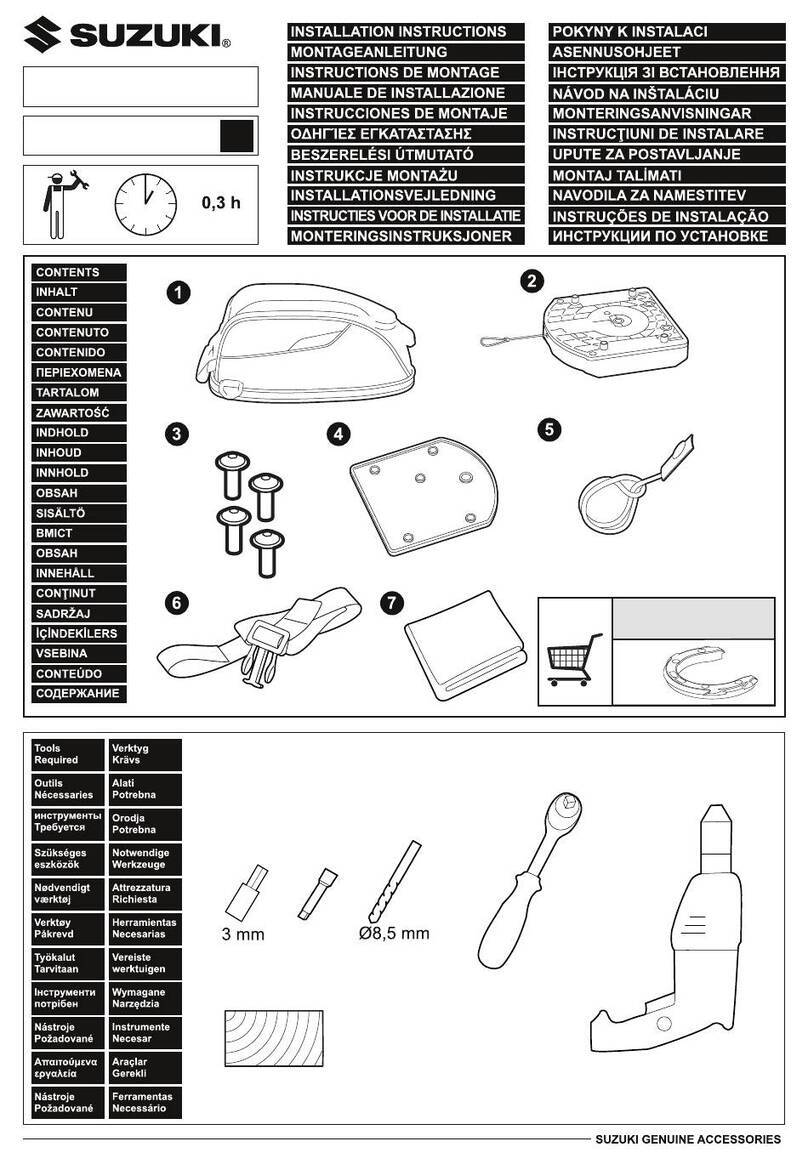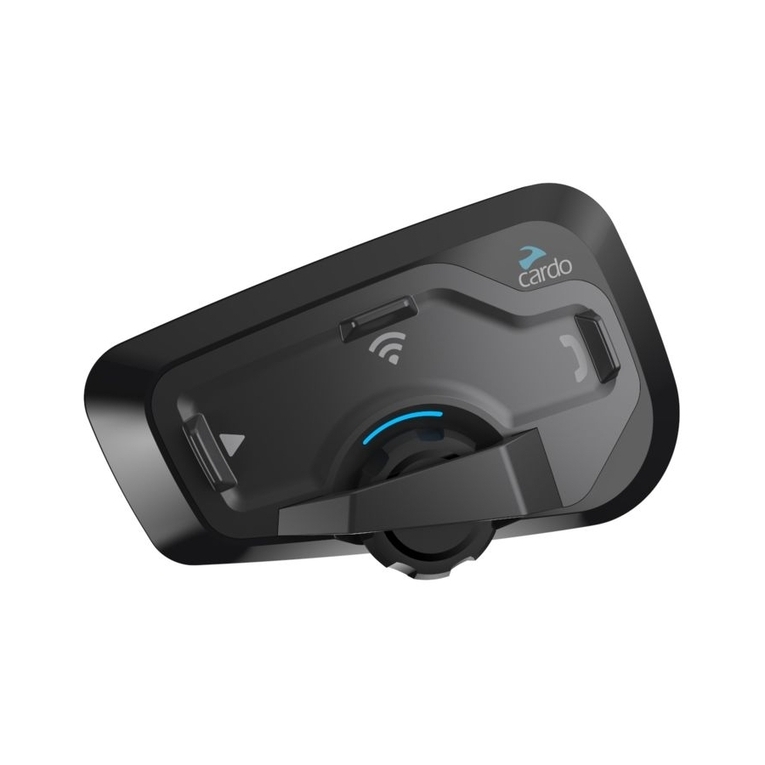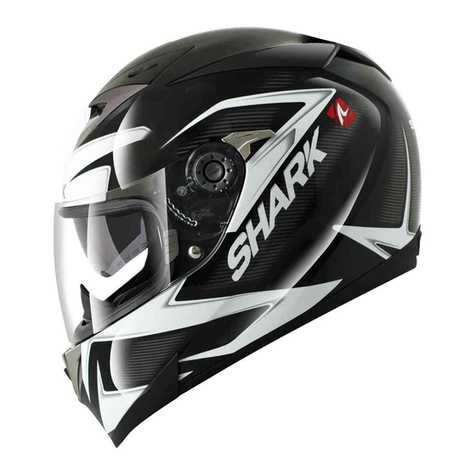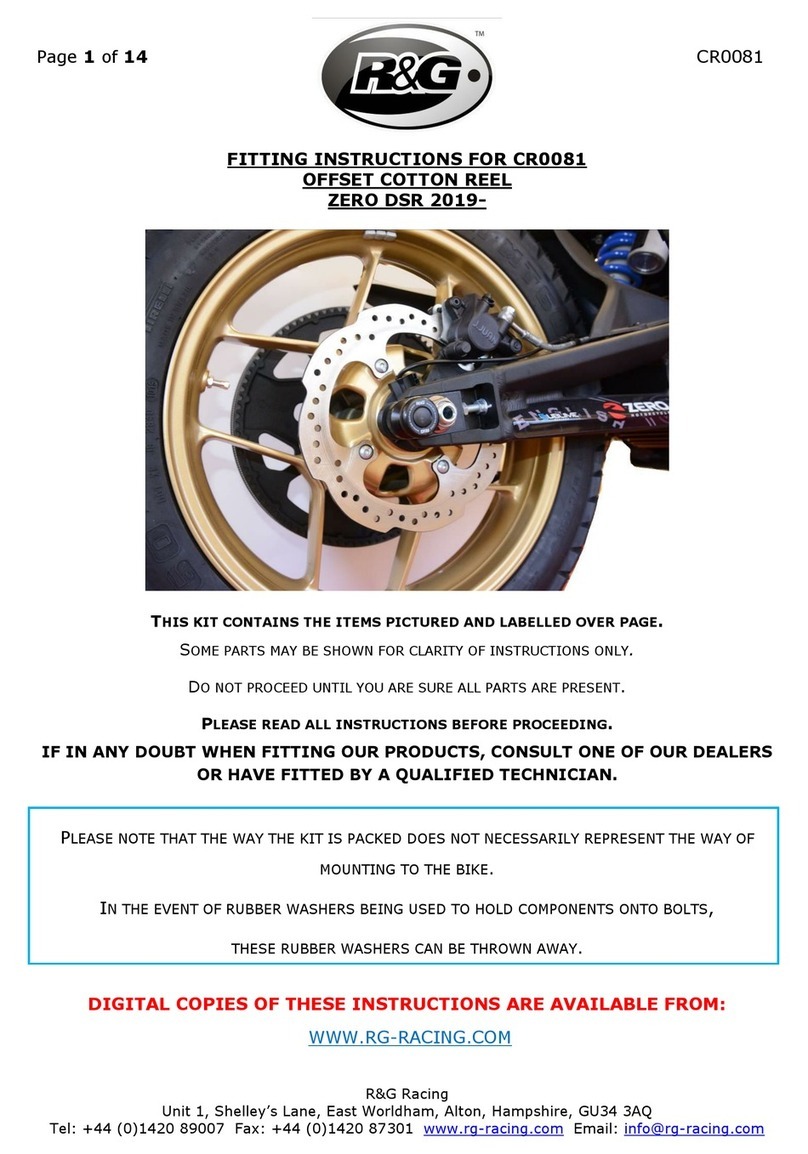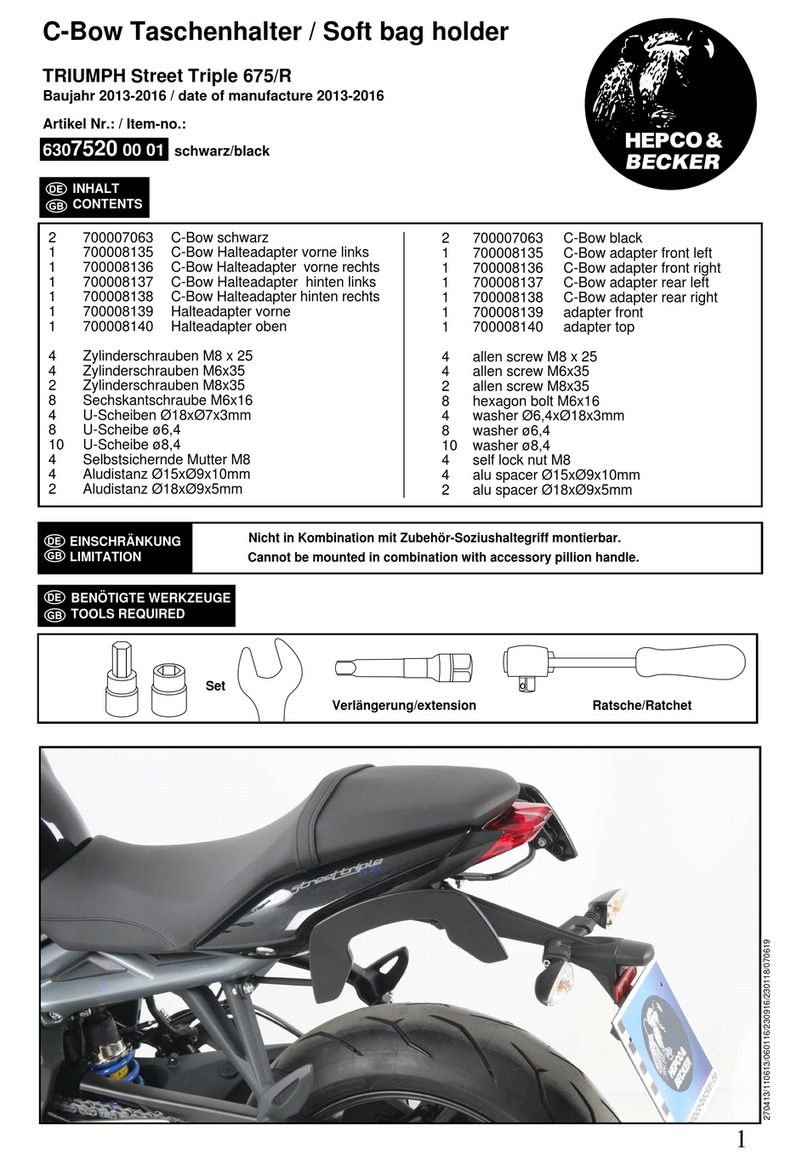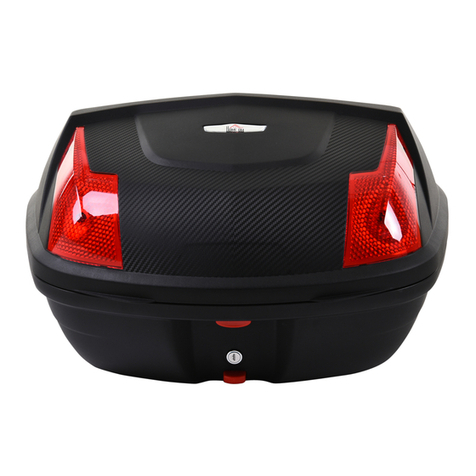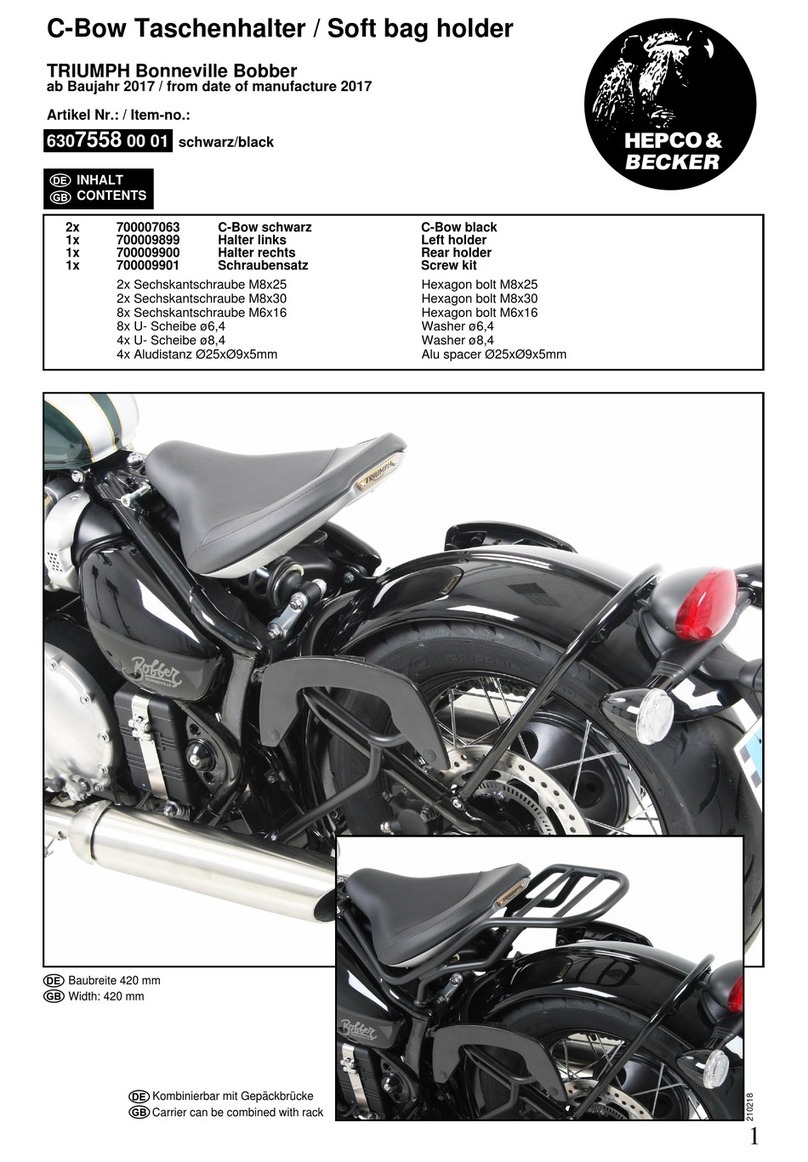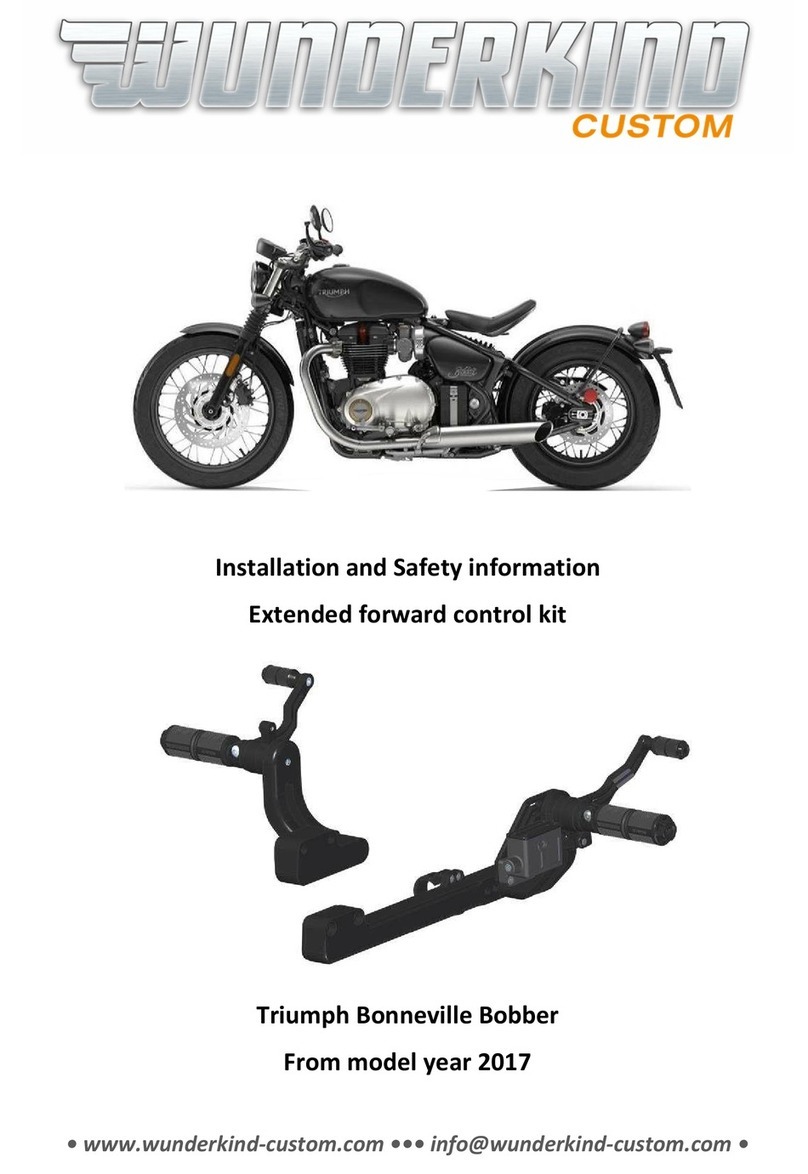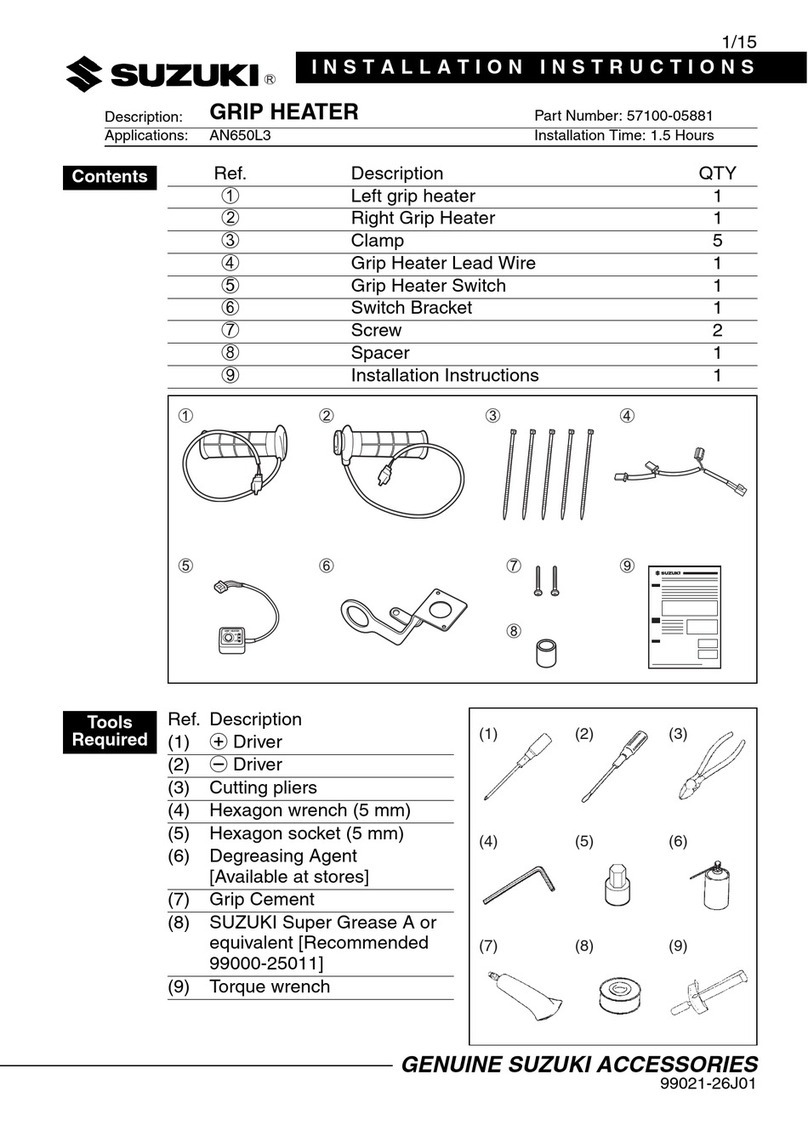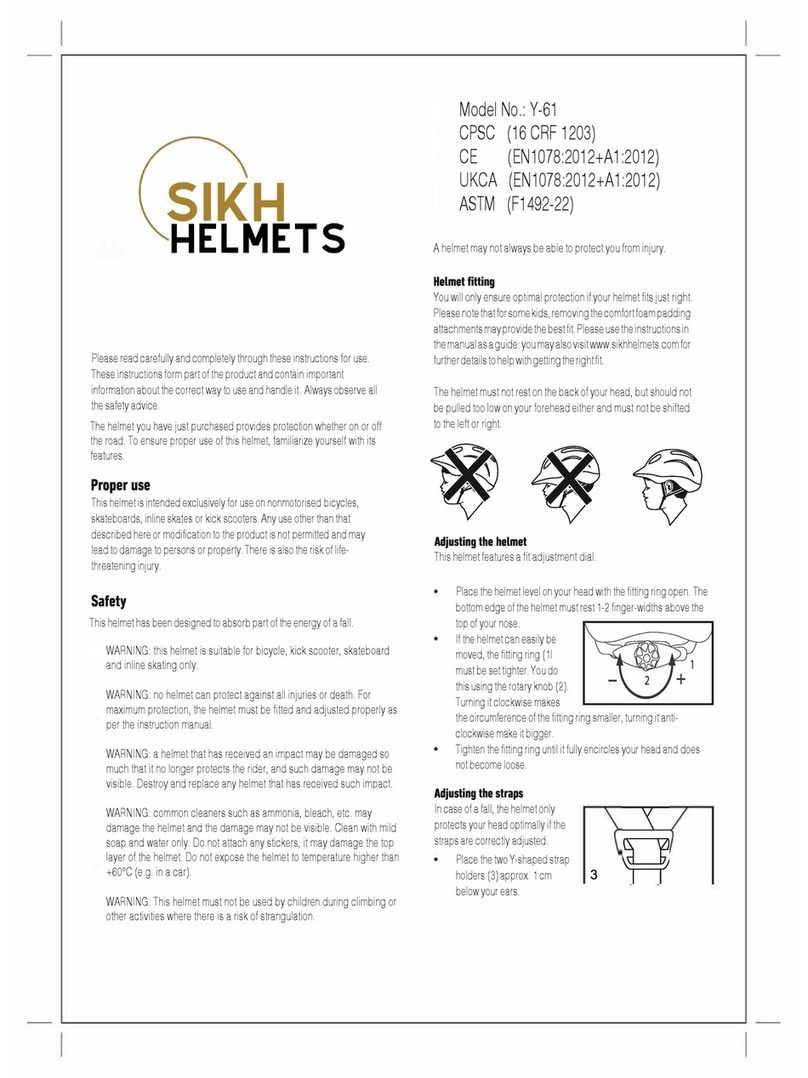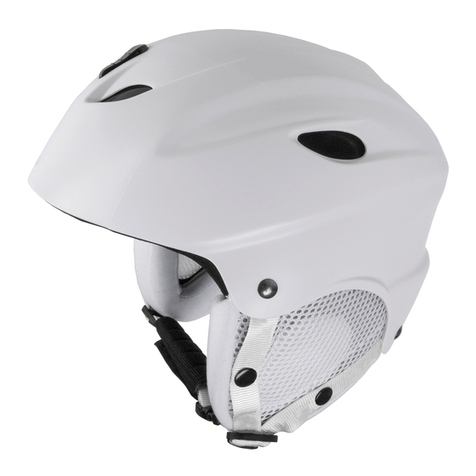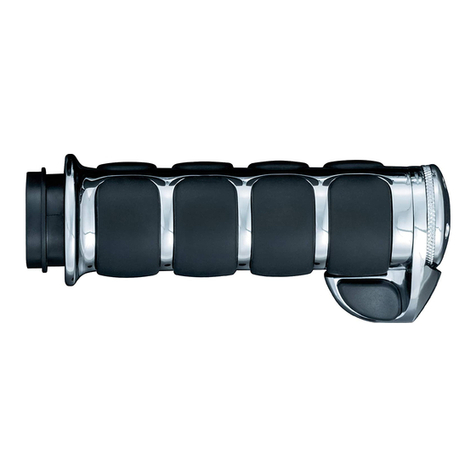If you are using the PINLOCK®* EVO lens, read the
instruction manual that comes packed with it.
PINLOCK®EVO lens
English
* PINLOCK
®
is a registered trademark of PINLOCK
SYSTEMS B.V.
Important Notice about Handling
the QSV-1 Sun Visor
English
Daytime use only. Never use PINLOCK
®
EVO lens at night. If the PINLOCK
®
EVO lens is used with a clear shield/
visor, its light transmission ratio will be
approximately 80%. This value does not
meet the light transmission standards
in the U.S. (VESC-8, 85%), or Europe
(ECE R22, 80%), so this accessory is for
“daytime use only” in these jurisdictions.
The PINLOCK
®
EVO lens is made of a
material that is easier to scratch than the
outer shield/visor. It should be treated
with great care.
The PINLOCK
®
EVO lens may obstruct
the rider’s view in some riding positions.
Remove the protective lm before using
the PINLOCK
®
EVO lens.
The PINLOCK
®
EVO lens demonstrates
high effectiveness in stopping fog by
absorbing moisture. However, if the
helmet is used continuously with the
lower vent in the closed position in low-
temperature, high-humidity conditions,
the lens can become saturated with water
vapor causing streaks and fog to appear.
If streaks or fog appears, it may obstruct
your view and be very dangerous! In this
case, open the lower air intake and/or
open the shield/visor to circulate air within
the helmet to remove the streaks and fog
from the helmet.
Purchase DKS301 for CNS-3 for
replacement of PINLOCK
®
EVO lens.
Pour utilisation diurne uniquement. Ne
jamais utiliser le lm antibuée PINLOCK®
EVO la nuit. Si le lm antibuée PINLOCK®
EVO est utilisé avec un écran transparent,
le ratio de transmission lumineuse sera
d’environs 80%. Cette valeur n’attend
pas les normes de transmission exigées
aux Etats Unis (VESC-8, 85%) ou en
Europe (ECE R22, 80%), cet accessoire
est donc pour une utilisation diurne
uniquement (« Daytime Use Only ») dans
ces juridictions.
Le lm antibuée PINLOCK® EVO est fait
d’un matériau plus sensible aux rayures
que l’écran. Il est donc nécessaire de le
manipuler et de l’entretenir avec le plus
grand soin.
Le film antibuée PINLOCK®EVO
peut gêner la vue du conducteur dans
certaines positions de conduite.
Retirez la protection du film antibuée
PINLOCK® EVO avant utilisation.
Le film antibuée PINLOCK® EVO
démontre une grande efcacité à éliminer
la buée par absorption d’humidité.
Toutefois, si le casque est utilisé en
continu avec la ventilation basse fermée,
par temps froid ou humide, le film
risque de saturer en vapeur d’eau et
de la condensation pourrait apparaitre.
Dans un tel cas, la condensation
risque d’obstruer le champ de vision et
rendre la conduite dangereuse. Il est
alors nécessaire d’ouvrir la ventilation
basse, afin d’augmenter l’apport d’air
frais et éradiquer ce phénomène de
condensation à l’intérieur du casque.
Achetez DKS301 pour CNS-3 pour
le remplacement du film antibuée
PINLOCK
®
EVO.
Only raise or lower the sun visor by
using the lever. Never raise or lower
the sun visor directly with your
hands. This may damage the sun visor’s
raising and lowering mechanism.
The QSV-1 sun visor is designed to provide
shade only and cannot function as a shield. Do not
ride with the shield open and using only the sun visor.
Do not use the sun visor together with sunglasses, as
this will dangerously darken your view!
Raise the sun visor while riding at night, through a
tunnel, or any other low-light condition.
Dirt and scratches on the sun visor may obstruct
your view while riding and can be very dangerous!
If the QSV-1 sun visor gets dirty or scratched, stop
using it immediately. Remove the sun visor and
clean or replace it.
The QSV-1 sun visor should be cleaned with a
solution of mild neutral soap and water. Rinse well
with pure water then wipe dry with a soft cloth. Do
not use any of the following cleaning materials:
hotwaterover40ºC;saltwater;anyacidicor
alkalidetergent;benzine,thinner,gasoline,or
otherorganic solvents;glasscleaner;orany
cleaner containing organic solvents. If any of
these cleaners are used, the sun visor’s chemical
nature may be altered and safety may be hindered.
The QSV-1 sun visor has undergone anti-
fogging treatment, but may develop fog in low
temperatures or high humidity. In this case, open
the lower air intake to circulate air or raise the sun
visor.
Under certain storage conditions, humidity may
cause the outer surface of the sun visor to become
white. If this happens, take a soft, dry cloth like one
for cleaning eyeglasses and wipe the sun visor to
restore it to its original condition.
Do not attach any stickers or tape on the QSV-1
sun visor. They may obstruct your view.
If the sun visor is not installed properly, it may drop
unexpectedly during riding and obstruct the rider’s
vision. After installing the QSV-1 sun visor, raise
and lower the sun visor several times to confirm
that the protruding section of the sun visor is fit
securely in the holder’s opening. Conrm that there
is no space between the sun visor and the holder.
Points importants sur le
maniement du pare-soleil QSV-1
Français
Relevezou abaissezlepare-soleil
uniquement à l’aide du levier. Ne
releveznin’abaissezjamaislepare-
soleil à la main. Le non-respect de cette
consigne peut endommager le mécanisme
de relevage et d’abaissement du pare-soleil.
L’écran solaire a pour unique but de protéger
de la lumière et ne fait pas office d’écran de
protection. Ne jamais rouler avec la l’écran ouvert
en abaissant seulement l’écran solaire.
Ne jamais utiliser l’écran solaire en combinaison
avec des lunettes de soleil, car le manque de
luminosité ainsi occasionné peut être dangereux
pour la visibilté !
Remontez l’écran solaire lors d’une utilisation
nocturne, d’un passage sous un tunnel ou dans
toute autre condition de mauvaise visibilité.
Les rayures et salissures peuvent obstruer le
champ de vision et rendre l’utilisation du casque
dangereuse ! Si l’écran solaire QSV-1 devient sale
ou rayé, arrêtez immédiatement son utilisation.
Retirez l’écran solaire et nettoyez le, ou si besoin
remplacez le.
L’écran solaire QSV-1 doit être nettoyé à l’aide
d’un mélange d’eau et de savon doux. Rincez
abondement à l’eau clair et essuyez avec un
chiffon doux N’utilisezaucundesproduitsde
nettoyage suivants: eau chaude de plus de
40°C,eausalée,détergentacideoualcalin,
essence, diluant, solvant organique, produit à
vitres, ou tout produit de nettoyage contenant
des solvants organiques. Si l’un de ces produits
nettoyants était utilisé, la structure chimique
de l’écran solaire en serait altérée, réduisant
grandement la sécurité de son utilisation.
L’écran solaire QSV-1 est dote d’un traitement
antibuée, mais une formation de buée est possible
lors d’utilisation à basse température. Dans ce
cas, ouvrez la ventilation basse an d’augmenter
la circulation de l’air ou remontez l’écran solaire.
Sous certaines conditions de stockage, l’humidité
peut rendre la surface externe de l’écran solaire
blanche. Si tel est le cas, essuyez l’écran à l’aide
d’un chiffon doux et sec, comme ceux utilisés pour
le nettoyage des lunettes, jusqu’à disparition des
traces blanches.
Si le pare-soleil n’est pas installé correctement,
il peut retomber inopinément pendant que vous
roulez et obstruer votre visibilité. Une fois le pare-
soleil QSV-1 installé, levez et abaissez le pare-
soleil plusieurs fois pour vous assurer que la partie
en saillie du pare-soleil est bien en place dans
l’ouverture du support. Contrôlez qu’il n’y a aucun
espace entre le pare-soleil et son support.
Si vous utilisez le film antibuée PINLOCK® EVO* ,
lisez le manuel d’utilisation fournit dans l’emballage.
Film antibuée PINLOCK®EVO
Français
* PINLOCK
®
est une marque déposée de PINLOCK
SYSTEMS B.V.
